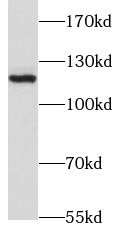Products
JMY antibody
Category:
Research Area:
- SPECIFICATIONS
- Product Name
- JMY antibody
- Catalogue No.
- FNab04443
- Size
- 100μg
- Form
- liquid
- Purification
- Immunogen affinity purified
- Purity
- ≥95% as determined by SDS-PAGE
- Clonality
- polyclonal
- Isotype
- IgG
- Storage
- PBS with 0.02% sodium azide and 50% glycerol pH 7.3, -20℃ for 12 months(Avoid repeated freeze / thaw cycles.)
Immunogen
- Immunogen
- junction mediating and regulatory protein, p53 cofactor
- Alternative Names
- JMY antibody, WHDC1L3 antibody
- UniProt ID
- Q8N9B5
- Observed MW
- 111 kDa
Application
- Tested Applications
- ELISA, WB, IHC, IF
- Recommended dilution
- WB: 1:500-1:2000; IHC: 1:20-1:200; IF: 1:10-1:100
Validated Images
 Jurkat cells were subjected to SDS PAGE followed by western blot with FNab04443(JMY Antibody) at dilution of 1:1000
Jurkat cells were subjected to SDS PAGE followed by western blot with FNab04443(JMY Antibody) at dilution of 1:1000
 Immunohistochemistry of paraffin-embedded human colon cancer tissue slide using FNab04443(JMY Antibody) at dilution of 1:50
Immunohistochemistry of paraffin-embedded human colon cancer tissue slide using FNab04443(JMY Antibody) at dilution of 1:50
 Immunofluorescent analysis of HeLa cells using FNab04443 (JMY antibody) at dilution of 1:25 and Rhodamine-Goat anti-Rabbit IgG
Immunofluorescent analysis of HeLa cells using FNab04443 (JMY antibody) at dilution of 1:25 and Rhodamine-Goat anti-Rabbit IgG
- Background
- Acts both as a nuclear p53/TP53-cofactor and a cytoplasmic regulator of actin dynamics depending on conditions. In nucleus, acts as a cofactor that increases p53/TP53 response via its interaction with p300/EP300. Increases p53/TP53-dependent transcription and apoptosis, suggesting an important role in p53/TP53 stress response such as DNA damage. In cytoplasm, acts as a nucleation-promoting factor for both branched and unbranched actin filaments. Activates the Arp2/3 complex to induce branched actin filament networks. Also catalyzes actin polymerization in the absence of Arp2/3, creating unbranched filaments. Contributes to cell motility by controlling actin dynamics. May promote the rapid formation of a branched actin network by first nucleating new mother filaments and then activating Arp2/3 to branch off these filaments. The p53/TP53-cofactor and actin activator activities are regulated via its subcellular location(By similarity).



